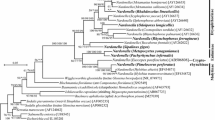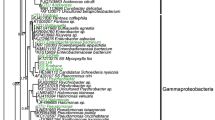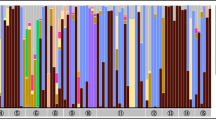Abstract
Some insects are infected with maternally inherited bacterial endosymbionts that protect them against pathogens or parasitoids. The weevil Sitona obsoletus (=Sitona lepidus) is invasive in New Zealand, and suspected to contain such defensive symbionts, because it is particularly resistant to a Moroccan strain of the parasitoid Microctonus aethiopoides (which successfully attacks many other weevil species), and shows geographic variation in susceptibility to an Irish strain of the same parasitoid. Using 454 pyrosequencing, we investigated the bacterial community associated with S. obsoletus, two other exotic weevils (Sitona discoideus and Listronotus bonariensis) and two endemic New Zealand weevils (Irenimus aequalis and Steriphus variabilis). We found that S. obsoletus was infected by one strain of Wolbachia and two strains of Rickettsia, none of which were found in any other weevil species examined. Using diagnostic PCR, we found that S. obsoletus in the Northland region, where parasitism is highly variable, were primarily infected with Wolbachia and Rickettsia strain 2, indicating that these two symbionts should be investigated for potential defensive properties. In comparison, S. discoideus lacked any apparent maternally inherited bacterial endosymbionts. In the other weevil species, we found a different strain of Wolbachia and two different strains of Spiroplasma. Two weevil species (St. variabilis and L. bonariensis) were infected with distinct strains of Nardonella, the ancestral endosymbiont of weevils, whereas three weevil species (S. obsoletus, S. discoideus, and I. aequalis) lacked evidence for Nardonella infection. However, I. aequalis was consistently infected with a novel Enterobacteriaceae strain, suggesting that a symbiont replacement may have taken place, similar to that described for other weevil clades.




Similar content being viewed by others
References
Oliver KM, Moran NA (2009) Defensive symbionts in aphids and other insects. In: White JF, Torres MS (eds) Defensive mutualism in microbial symbiosis. Taylor & Francis, London, pp 129–147
Hedges LM, Brownlie JC, O’Neill SL, Johnson KN (2008) Wolbachia and virus protection in insects. Science 322(5902):702. doi:10.1126/science.1162418
Teixeira L, Ferreira A, Ashburner M (2008) The bacterial symbiont Wolbachia induces resistance to RNA viral infections in Drosophila melanogaster. PLoS Biol 6(12):2753–2763. doi:10.1371/journal.pbio.1000002
Jaenike J, Unckless R, Cockburn SN, Boelio LM, Perlman SJ (2010) Adaptation via symbiosis: recent spread of a Drosophila defensive symbiont. Science 329(5988):212–215. doi:10.1126/science.1188235
Kaltenpoth M, Göttler W, Herzner G, Strohm E (2005) Symbiotic bacteria protect wasp larvae from fungal infestation. Curr Biol 15(5):475–479. doi:10.1016/j.cub.2004.12.084
Scarborough CL, Ferrari J, Godfray HCJ (2005) Aphid protected from pathogen by endosymbiont. Science 310(5755):1781–1781. doi:10.1126/science.1120180
Lukasik P, van Asch M, Guo HF, Ferrari J, Godfray HCJ (2013) Unrelated facultative endosymbionts protect aphids against a fungal pathogen. Ecol Lett 16(2):214–218. doi:10.1111/ele.12031
Kellner RLL (2002) Molecular identification of an endosymbiotic bacterium associated with pederin biosynthesis in Paederus sabaeus (Coleoptera : Staphylinidae). Insect Biochem Mol 32(4):389–395. doi:10.1016/S0965-1748(01)00115-1
Oliver KM, Russell JA, Moran NA, Hunter MS (2003) Facultative bacterial symbionts in aphids confer resistance to parasitic wasps. Proc Natl Acad Sci U S A 100(4):1803–1807. doi:10.1073/pnas.0335320100
Xie JL, Vilchez I, Mateos M (2010) Spiroplasma bacteria enhance survival of Drosophila hydei attacked by the parasitic wasp Leptopilina heterotoma. PLoS ONE 5(8):e12149. doi:10.1371/journal.pone.0012149
Radcliffe EB, Flanders KL (1998) Biological control of alfalfa weevil in North America. Integr Pest Manag Rev 3(4):225–242. doi:10.1023/A:1009611219360
Hsiao T (1996) Studies of interactions between alfalfa weevil strains, Wolbachia endosymbionts and parasitoids. In: Symondson WOC, Liddell JE (eds) The ecology of agricultural pests. Chapman & Hall, London, pp 51–72
Leu S-JC, Li JK-K, Hsiao TH (1989) Characterization of Wolbachia postica, the cause of reproductive incompatibility among alfalfa weevil strains. J Invert Pathol 54(2):248–259. doi:10.1016/0022-2011(89)90035-9
Stouthamer R, Breeuwer JA, Hurst GD (1999) Wolbachia pipientis: microbial manipulator of arthropod reproduction. Annu Rev Microbiol 53:71–102. doi:10.1146/annurev.micro.53.1.71
Werren JH, Baldo L, Clark ME (2008) Wolbachia: master manipulators of invertebrate biology. Nat Rev Microbiol 6(10):741–751. doi:10.1038/nrmicro1969
Toju H, Fukatsu T (2011) Diversity and infection prevalence of endosymbionts in natural populations of the chestnut weevil: relevance of local climate and host plants. Mol Ecol 20(4):853–868. doi:10.1111/j.1365-294X.2010.04980.x
Toju H, Tanabe AS, Notsu Y, Sota T, Fukatsu T (2013) Diversification of endosymbiosis: replacements, co-speciation and promiscuity of bacteriocyte symbionts in weevils. ISME J 7(7):1378–1390. doi:10.1038/ismej.2013.27
Merville A, Venner S, Henri H, Vallier A, Menu F, Vavre F, Heddi A, Bel-Venner M-C (2013) Endosymbiont diversity among sibling weevil species competing for the same resource. BMC Evol Biol 13(1):28. doi:10.1186/1471-2148-13-28
Vankosky MA, Carcamo HA, Dosdall LM (2011) Identification of potential natural enemies of the pea leaf weevil. Sitona lineatus L. in western Canada. J Appl Entomol 135:293–301. doi:10.1111/j.1439-0418.2010.01542.x
Moorhouse E, Charnley A, Gillespie A (1992) A review of the biology and control of the vine weevil, Otiorhynchus sulcatus (Coleoptera: Curculionidae). Ann Appl Biol 121(2):431–454. doi:10.1111/j.1744-7348.1992.tb03455.x
Murphy S, Briscoe B (1999) The red palm weevil as an alien invasive: biology and the prospects for biological control as a component of IPM. Biocontrol News Inf 20:35N–46N
Gurr GM, Wratten SD (2000) Biological control: measures of success. Kluwer, Dordrecht, p 429
Phillips CB, Vink CJ, Blanchet A, Hoelmer KA (2008) Hosts are more important than destinations: what genetic variation in Microctonus aethiopoides (Hymenoptera: Braconidae) means for foreign exploration for natural enemies. Mol Phylogenet Evol 49(2):467–476. doi:10.1016/j.ympev.2008.08.005
Babendreier D, Bigler F, Kuhlmann U (2005) Methods used to assess non-target effects of invertebrate biological control agents of arthropod pests. Biocontrol 50(6):821–870. doi:10.1007/s10526-005-3633-3
Goldson S, Dyson C, Proffitt J, Frampton E, Logan J (1985) The effect of Sitona discoideus Gyllenhal (Coleoptera: Curculionidae) on lucerne yields in New Zealand. B Entomol Res 75(3):429–442. doi:10.1017/S000748530001453X
Stufkens M, Farrell J, Goldson S (1987) Establishment of Microtonus aethiopoides, a parasitoid of the sitona weevil in New Zealand. Proc New Zealand Weed and Pest Control Conference. New Zealand Weed and Pest Control Society Inc., pp. 31–35
Kean JM, Barlow ND (2000) Long-term assessment of the biological control of Sitona discoideus by Microctonus aethiopoides and test of a model. Biocontrol Sci Technol 10(3):215–221. doi:10.1080/09583150050044493
Barratt B, Evans A, Ferguson C, Barker G, McNeill M, Phillips C (1997) Laboratory nontarget host range of the introduced parasitoids Microctonus aethiopoides and M. hyperodae (Hymenoptera: Braconidae) compared with field parasitism in New Zealand. Environ Entomol 26(3):694–702
Barratt B, Evans A, Ferguson C, O’Callaghan M (1997) Potential for biocontrol of Sitona lepidus Gyllenhal by Microctonus spp. Proc New Zealand Plant Protection Conference. New Zealand Plant Protection Society Inc, pp. 37–40
McNeill M, Barratt B, Evans A (2000) Behavioural acceptability of Sitona lepidus (Coleoptera: Curculionidae) to the parasitoid Microctonus aethiopoides (Hymenoptera: Braconidae) using the pathogenic bacterium Serratia marcescens Bizio. Biocontrol Sci Technol 10(3):205–213. doi:10.1080/09583150050044484
Sundaralingam S, Hower A, Kim K (2001) Host selection and reproductive success of French and Moroccan populations of the parasitoid, Microctonus aethiopoides (Hymenoptera: Braconidae). BioControl 46(1):25–41. doi:10.1023/A:1009914907209
Phillips C, Cane R, Mee J, Chapman H, Hoelmer K, Coutinot D (2002) Intraspecific variation in the ability of Microctonus aethiopoides (Hymenoptera: Braconidae) to parasitise Sitona lepidus (Coleoptera: Curculionidae). N Z J Agric 45(4):295–303. doi:10.1080/00288233.2002.9513519
Vink C, Phillips C, Mitchell A, Winder L, Cane R (2003) Genetic variation in Microctonus aethiopoides (Hymenoptera: Braconidae). Biol Control 28(2):251–264. doi:10.1016/S1049-9644(03)00103-8
Goldson SL, McNeill MR, Proffitt JR, Barratt BIP (2005) Host specificity testing and suitability of a European biotype of the braconid parasitoid Microctonus aethiopoides as a biological control agent against Sitona lepidus (Coleoptera : Curculionidae) in New Zealand. Biocontrol Sci Technol 15(8):791–813. doi:10.1080/09583150500136444
Gerard P, Eden T, Hardwick S, Mercer C, Slay M, Wilson D (2007) Initial establishment of the Irish strain of Microctonus aethiopoides in New Zealand. N Z Plant Protect 60:203
Gerard P, Wilson D, Eden T (2010) Clover root weevil biocontrol distribution in the North Island—release tactics and outcomes. Proc N Z Grassl Assoc 72:85–89
Goldson SL, McNeill MR, Gerard PJ, Proffitt JR, Phillips CB, Cane RP, Murray PJ (2004) British-based search for natural enemies of the clover root weevil, Sitona lepidus in Europe. N Z J Zool 31(3):233–240
Bright DE (1994) Revision of the genus Sitona (Coleoptera, Curculionidae) of North America. Ann Entomol Soc Am 87(3):277–306
Goldson SL, Emberson RM (1981) Reproductive morphology of the argentine stem weevil, Hyperodes bonariensis (Coleoptera, Curculionidae). N Z J Zool 8(1):67–77. doi:10.1080/03014223.2004.9518375
Barratt BIP, Kuschel G (1996) Broad-nosed weevils (Curculionidae: Brachycerinae: Entimini) of the Lammermoor and Rock and Pillar Ranges in Otago, with descriptions of four new species of Irenimus. N Z J Zool 23(4):359–374. doi:10.1080/03014223.1996.9518096
Brady CM, White JA (2013) Cowpea aphid (Aphis craccivora) associated with different host plants has different facultative endosymbionts. Ecol Entomol 38(4):433–437. doi:10.1111/een.12020
Dowd SE, Callaway TR, Wolcott RD, Sun Y, McKeehan T, Hagevoort RG, Edrington TS (2008) Evaluation of the bacterial diversity in the feces of cattle using 16S rDNA bacterial tag-encoded FLX amplicon pyrosequencing (bTEFAP). BMC Microbiol 8(1):125. doi:10.1186/1471-2180-8-125
Medina RF, Nachappa P, Tamborindeguy C (2011) Differences in bacterial diversity of host-associated populations of Phylloxera notabilis Pergande (Hemiptera: Phylloxeridae) in pecan and water hickory. J Evol Biol 24(4):761–771. doi:10.1111/j.1420-9101.2010.02215.x
Ishak HD, Plowes R, Sen R, Kellner K, Meyer E, Estrada DA, Dowd SE, Mueller UG (2011) Bacterial diversity in Solenopsis invicta and Solenopsis geminata ant colonies characterized by 16S amplicon 454 pyrosequencing. Microb Ecol 61(4):821–831. doi:10.1007/s00248-010-9793-4
Steelman SM, Chowdhary BP, Dowd S, Suchodolski J, Janečka JE (2012) Pyrosequencing of 16S rRNA genes in fecal samples reveals high diversity of hindgut microflora in horses and potential links to chronic laminitis. BMC Vet Res 8(1):231. doi:10.1186/1746-6148-8-231
Baldo L, Hotopp JCD, Jolley KA, Bordenstein SR, Biber SA, Choudhury RR, Hayashi CY, Maiden MCY, Tettelin H, Werren JH (2006) Multilocus sequence typing system for the endosymbiont Wolbachia pipientis. Appl Environ Microbiol 72(11):7098–7110. doi:10.1128/AEM. 00731-06
Toju H, Hosokawa T, Koga R, Nikoh N, Meng XY, Kimura N, Fukatsu T (2010) “Candidatus Curculioniphilus buchneri,” a novel clade of bacterial endocellular symbionts from weevils of the genus Curculio. Appl Environ Microbiol 76(1):275–282. doi:10.1128/AEM. 02154-09
Benson DA, Cavanaugh M, Clark K, Karsch-Mizrachi I, Lipman DJ, Ostell J, Sayers EW (2013) GenBank. Nucleic Acids Res 41:D36–D42. doi:10.1093/nar/gks1195
Jolley KA, Maiden MCJ (2010) BIGSdb: scalable analysis of bacterial genome variation at the population level. BMC Bioinforma 11(1):595. doi:10.1186/1471-2105-11-595
Edgar RC (2004) MUSCLE: multiple sequence alignment with high accuracy and high throughput. Nucleic Acids Res 32(5):1792–1797. doi:10.1093/nar/gkh340
Gouy M, Guindon S, Gascuel O (2010) SeaView Version 4: a multiplatform graphical user interface for sequence alignment and phylogenetic tree building. Mol Biol Evol 27(2):221–224. doi:10.1093/molbev/msp259
Guindon S, Dufayard JF, Lefort V, Anisimova M, Hordijk W, Gascuel O (2010) New algorithms and methods to estimate maximum-likelihood phylogenies: assessing the performance of PhyML 3.0. Syst Biol 59(3):307–321. doi:10.1093/sysbio/syq010
Baldo L, Bordenstein S, Wernegreen JJ, Werren JH (2006) Widespread recombination throughout Wolbachia genomes. Mol Biol Evol 23(2):437–449. doi:10.1093/molbev/msj049
Lefevre C, Charles H, Vallier A, Delobel B, Farrell B, Heddi A (2004) Endosymbiont phylogenesis in the Dryophthoridae weevils: evidence for bacterial replacement. Mol Biol Evol 21(6):965–973. doi:10.1093/molbev/msh063
Kuriwada T, Hosokawa T, Kumano N, Shiromoto K, Haraguchi D, Fukatsu T (2010) Biological role of Nardonella endosymbiont in its weevil host. PLoS ONE 5(10):e13101. doi:10.1371/journal.pone.0013101
Bian GW, Xu Y, Lu P, Xie Y, Xi ZY (2010) The endosymbiotic bacterium Wolbachia induces resistance to Dengue virus in Aedes aegypti. PLoS Pathog 6(4):e1000833. doi:10.1371/journal.ppat.1000833
Perlman SJ, Hunter MS, Zchori-Fein E (2006) The emerging diversity of Rickettsia. Proc R Soc B Biol Sci 273(1598):2097–2106. doi:10.1098/rspb.2006.3541
White JA (2011) Caught in the act: rapid, symbiont-driven evolution. Bioessays 33(11):823–829. doi:10.1002/bies.201100095
Dobson SL, Bourtzis K, Braig HR, Jones BF, Zhou WG, Rousset F, O’Neill SL (1999) Wolbachia infections are distributed throughout insect somatic and germ line tissues. Insect Biochem Mol 29(2):153–160. doi:10.1016/s0965-1748(98)00119-2
Gottlieb Y, Ghanim M, Chiel E, Gerling D, Portnoy V, Steinberg S, Tzuri G, Horowitz AR, Belausov E, Mozes-Daube N, Kontsedalov S, Gershon M, Gal S, KatZir N, Zchori-Fein E (2006) Identification and localization of a Rickettsia sp in Bemisia tabaci (Homoptera : Aleyrodidae). Appl Environ Microbiol 72(5):3646–3652. doi:10.1128/aem. 72.5.3646-3652.2006
Loan C, Holdaway F (1961) Microctonus aethiops (Nees) auctt. and Perilitus rutilus (Nees)(Hymenoptera: Braconidae), European parasites of Sitona weevils (Coleoptera: Curculionidae). Can Entomol 93(12):1057–1079. doi:10.4039/Ent931057-12
Gerard P, Eden T, Wilson D, Burch G (2008) Distribution of the clover root weevil biocontrol agent in the North Island of New Zealand. N Z Plant Protect 60:24–30
McNeill M, Proffitt J, Gerard P, Goldson S (2006) Collections of Microctonus aethiopoides Loan (Hymenoptera: Braconidae) from Ireland. N Z Plant Protect 59:290
Phillips C, Iline I, Vink C, Winder L, McNeill M (2006) Methods to distinguish between the Microctonus aethiopoides strains that parasitise Sitona lepidus and Sitona discoideus. N Z Plant Protect 59:297
Rouchet R, Vorburger C (2012) Strong specificity in the interaction between parasitoids and symbiont-protected hosts. J Evol Biol 25(11):2369–2375. doi:10.1111/j.1420-9101.2012.02608.x
Rouchet R, Vorburger C (2014) Experimental evolution of parasitoid infectivity on symbiont-protected hosts leads to the emergence of genotype specificity. Evolution 68(6):1607–1616. doi:10.1111/evo.12377
Hurst GDD, von der Schulenburg JHG, Majerus TMO, Bertrand D, Zakharov IA, Baungaard J, Volkl W, Stouthamer R, Majerus MEN (1999) Invasion of one insect species, Adalia bipunctata, by two different male-killing bacteria. Insect Mol Biol 8(1):133–139. doi:10.1046/j.1365-2583.1999.810133.x
Regassa LB, Gasparich GE (2006) Spiroplasmas: evolutionary relationships and biodiversity. Front Biosci 11:2983–3002. doi:10.2741/2027
de Vries EJ, Jacobs G, Breeuwer JAJ (2001) Growth and transmission of gut bacteria in the western flower thrips, Frankliniella occidentalis. J Invert Pathol 77(2):129–137. doi:10.1006/jipa.2001.5010
Morris CE, Monier JM (2003) The ecological significance of biofilm formation by plant-associated bacteria. Annu Rev Phytopathol 41:429–453. doi:10.1146/annurev.phyto.41.022103.134521
Barash I, Manulis-Sasson S (2009) Recent evolution of bacterial pathogens: the gall-forming Pantoea agglomerans case. Annu Rev Phytopathol 47:133–152. doi:10.1146/annurev-phyto-080508-081803
Moro CV, Tran FH, Raharimalala FN, Ravelonandro P, Mavingui P (2013) Diversity of culturable bacteria including Pantoea in wild mosquito Aedes albopictus. BMC Microbiol 13(1):70. doi:10.1186/1471-2180-13-70
Kikuchi Y, Hayatsu M, Hosokawa T, Nagayama A, Tago K, Fukatsu T (2012) Symbiont-mediated insecticide resistance. Proc Natl Acad Sci U S A 109(22):8618–8622. doi:10.1073/pnas.1200231109
de Vries EJ, Jacobs G, Sabelis MW, Menken SBJ, Breeuwer JAJ (2004) Diet-dependent effects of gut bacteria on their insect host: the symbiosis of Erwinia sp. and western flower thrips. Proc R Soc B Biol Sci 271(1553):2171–2178. doi:10.1098/rspb.2004.2817
Conord C, Despres L, Vallier A, Balmand S, Miquel C, Zundel S, Lemperiere G, Heddi A (2008) Long-term evolutionary stability of bacterial endosymbiosis in curculionoidea: additional evidence of symbiont replacement in the dryophthoridae family. Mol Biol Evol 25(5):859–868. doi:10.1093/molbev/msn027
Buchner P (1965) Endosymbiosis of animals with plant microorganisms. Interscience, New York
Nardon P, Grenier A-M (1991) Serial endosymbiosis theory and weevil evolution: the role of symbiosis. In: Margulis L, Fester R (eds) Symbiosis as a source of evolutionary innovation: speciation and morphogenesis. MIT Press, Cambridge, pp 153–169
Heddi A, Nardon P (2005) Sitophilus oryzae L.: a model for intracellular symbiosis in the Dryophthoridae weevils (Coleoptera). Symbiosis 39(1):1–11
Moran NA, McCutcheon JP, Nakabachi A (2008) Genomics and evolution of heritable bacterial symbionts. Annu Rev Genet 42:165–190. doi:10.1146/annurev.genet.41.110306.130119
de Castro AJV, Alonso-Zarazaga MA, Outerelo R (2007) Systematics of Sitonini (Coleoptera : Curculionidae : Entiminae), with a hypothesis on the evolution of feeding habits. Syst Entomol 32(2):312–331. doi:10.1111/j.1365-3113.2006.00368.x
McKenna DD, Sequeira AS, Marvaldi AE, Farrell BD (2009) Temporal lags and overlap in the diversification of weevils and flowering plants. Proc Natl Acad Sci U S A 106(17):7083–7088. doi:10.1073/pnas.0810618106
Acknowledgments
We thank A. Dehnel and A. Maldonado for technical support, and three anonymous reviewers for helpful commentary on earlier versions of the manuscript. This research was funded by the University of Kentucky Department of Entomology, USDA National Institute of Food and Agriculture, Hatch project KY008052, the New Zealand Ministry for Business, Innovation and Employment through contract LINX0304, Ecosystems Bioprotection, and the AgResearch Curiosity Fund (A18906).
Author information
Authors and Affiliations
Corresponding author
Additional information
The nucleotide sequence data reported in this manuscript have been submitted to the DDBJ/EMBL/GenBank databases under accession numbers KJ494864-8, KJ522437-49, and the sequence read archive under project accession number SRP041582; all have been publicly released as of 31 Aug, 2014.
Rights and permissions
About this article
Cite this article
White, J.A., Richards, N.K., Laugraud, A. et al. Endosymbiotic Candidates for Parasitoid Defense in Exotic and Native New Zealand Weevils. Microb Ecol 70, 274–286 (2015). https://doi.org/10.1007/s00248-014-0561-8
Received:
Accepted:
Published:
Issue Date:
DOI: https://doi.org/10.1007/s00248-014-0561-8




